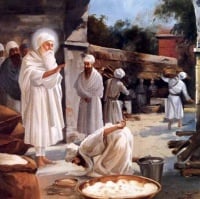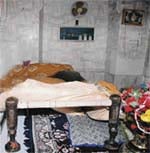Manji System: Difference between revisions
Hari singh (talk | contribs) No edit summary |
Allenwalla (talk | contribs) mNo edit summary |
||
| Line 1: | Line 1: | ||
[[Image:GuruAmardas Handal.jpg|thumb|200px|right|Langar Sewadar, Bhai Handal bows to Guru Amar Das]] | [[Image:GuruAmardas Handal.jpg|thumb|200px|right|Langar Sewadar, Bhai Handal bows to Guru Amar Das]] | ||
This is a term used from the time of [[Guru Amar Das]] in 1552 to refer to the various regions in Punjab and other places to represent a group forming a division or sub- | This is a term used from the time of [[Guru Amar Das]] in 1552 to refer to the various regions in Punjab and other places to represent a group forming a division or sub-group for the efficient administration of the affairs of the Sikhs. At [[Goindwal]], Guru Amar Das propagated the Sikh faith in a logical and well planned manner of administration. He himself visited and sent Sikh missionaries to different parts of [[India]] to spread [[Sikhism]]. He divided the Sikh [[Sangat]] area into 22 branches called [[Manjis]] and appointed a local devout Sikh preacher as their leader at each place. The preacher sat on a Manji (a cot) while the congregation all sat around the Manji or cot. Here are the initial 16 names of the people (of 22 manjis) he appointed to preach Sikhism. | ||
'''In the area of Majha ([[Amritsar]], [[Lahore]], [[Sialkot]])''' | '''In the area of Majha ([[Amritsar]], [[Lahore]], [[Sialkot]])''' | ||
| Line 64: | Line 64: | ||
Bhai Mai Das, a strict Vaishnav came in contact with Guru Amar Das and became his disciple. When he came to see the Guru he was informed that unless he would first have to eat from the Guru’s kitchen and then see him. Being a strict Vaishnav he did not do that, so he left the place to complete his pilgrimage. | Bhai Mai Das, a strict Vaishnav came in contact with Guru Amar Das and became his disciple. When he came to see the Guru he was informed that unless he would first have to eat from the Guru’s kitchen and then see him. Being a strict Vaishnav he did not do that, so he left the place to complete his pilgrimage. | ||
According to Sikh history, one day he heard a voice,”You have not eaten food from the Guru’s kitchen and you did not see him, so you will not obtain perfection. If you desire to do so then first behold Guru Amar Das.” Upon this Bhai Mai Das returned to Goindwal and partook langar and then was allowed to see the Guru. The Guru welcomed him, “Come, Mai Das, thou art a special saint of God.” The Guru initiated him as his Sikh, gave him “naam” and bestowed on him the spiritual power of conferring salvation on others. | According to Sikh history, one day he heard a voice, ”You have not eaten food from the Guru’s kitchen and you did not see him, so you will not obtain perfection. If you desire to do so then first behold Guru Amar Das.” Upon this Bhai Mai Das returned to Goindwal and partook langar and then was allowed to see the Guru. The Guru welcomed him, “Come, Mai Das, thou art a special saint of God.” The Guru initiated him as his Sikh, gave him “naam” and bestowed on him the spiritual power of conferring salvation on others. | ||
The old structure where the “manji” was set up has been demolished. | The old structure where the “manji” was set up has been demolished. Marble has now replaced the old “Nanakshahi” bricks. | ||
The history of Narli, written by Heera Singh of the village stated that the “manji “ was shifted from Chathianwala to Narli by Bhai Manak Das due to old age of Bhai Mai Das. Hence, the “manji” came to be known in the joint name of both Bhai Mai Das and Bhai Manak Das. However, the “samadhas” of Bhai Manak Das at Chathianwala had been destroyed with the passage of time. | The history of Narli, written by Heera Singh of the village stated that the “manji “ was shifted from Chathianwala to Narli by Bhai Manak Das due to the old age of Bhai Mai Das. Hence, the “manji” came to be known in the joint name of both Bhai Mai Das and Bhai Manak Das. However, the “samadhas” of Bhai Manak Das at Chathianwala had been destroyed with the passage of time. | ||
Revision as of 10:32, 14 November 2007
This is a term used from the time of Guru Amar Das in 1552 to refer to the various regions in Punjab and other places to represent a group forming a division or sub-group for the efficient administration of the affairs of the Sikhs. At Goindwal, Guru Amar Das propagated the Sikh faith in a logical and well planned manner of administration. He himself visited and sent Sikh missionaries to different parts of India to spread Sikhism. He divided the Sikh Sangat area into 22 branches called Manjis and appointed a local devout Sikh preacher as their leader at each place. The preacher sat on a Manji (a cot) while the congregation all sat around the Manji or cot. Here are the initial 16 names of the people (of 22 manjis) he appointed to preach Sikhism.
In the area of Majha (Amritsar, Lahore, Sialkot)
- 1. Manak Chand Jhinwar (Water Carrier) at Variowal in Amritsar.
- 2. Sada ram, a Blacksmith near Amritsar.
- 3. Hindal at Jandiala near Amritsar.
- 4. Gangu Shah banker at Lahore.
- 5. Mutho-Murari, a devoted couple, at Chunian in Lahore Dist.
In Jallandar Doab
- 6. Paro Julka at Jalandar.
- 7. Mahesh Dhir at Sultanpur Lodi.
In Kangra Hills
- 8. Sawan mal, Nephew of Guru Amar Das, at Haripur Guler.
- 9. Name not given, at Dharamsala.
Kashmir Hills
- 10. Phirya at Mirpur.
Malwa (Area of Patiala, Ludhiana, Bhatinda)
- 11. Kheira at Firozpur.
- 12. Mai Das Bairagi in charge of Ludhiana dist.
- 13. Mai Bhago at village Wayun, tehsil Kharar, dist. Rupar.
- 14. Mai Sewan at Village Gardnoh in Patiala District.
- 15. Sachna Shah in charge of Ambala distt.
Sind
- 16. Lalu in charge of some area in Sind.
- 17 to 22: Unknown
Guru Amar Das was impressed with Bhai Gurdas' thorough knowledge of Hindi and Sanskrit and the Hindu scriptures. Following the tradition of sending out Masands across the country, Guru Amar Das deputed Bhai Gurdas to Agra to spread the gospel of Sikhism. Before leaving, Guru Amar Das prescribed the following routine for Sikhs:
"He who calls himself a Sikh of the True Guru, He must get up in the morning and say his prayers. He must rise in the early hours and bathe in the holy tank. He must meditate on God as advised by the Guru. And rid himself of the afflictions of sins and evil. As the day dawns, he should recite scriptures, and repeat God's name in every activity. He to whom the Guru takes kindly is shown the path. Nanak! I seek the dust of the feet of the Guru's Sikh who himself remembers God and makes others remember Him." (Gauri)
In the News
Established by Guru Amar Das, ‘manji’ still intact by Varinder Walia from Narli (Tarn Taran), September 20, 2007
More than four-and-half-century old “manji”(one of the 22 dioceses) established by Guru Amar Das is still intact at Gurdwara Manji Sahib.
The gurdwara was raised in memory of Bhai Mai Manak Das in the border village near zero line. The Narli village of Majha region came to be one of the major centres of Sikhism following establishment of the “manji” .
Guru Amar Das copied the old system of administration when he set up his 22 “manjis”. Bhai Mai Das held one of these.
Bhai Mai Das, a strict Vaishnav came in contact with Guru Amar Das and became his disciple. When he came to see the Guru he was informed that unless he would first have to eat from the Guru’s kitchen and then see him. Being a strict Vaishnav he did not do that, so he left the place to complete his pilgrimage.
According to Sikh history, one day he heard a voice, ”You have not eaten food from the Guru’s kitchen and you did not see him, so you will not obtain perfection. If you desire to do so then first behold Guru Amar Das.” Upon this Bhai Mai Das returned to Goindwal and partook langar and then was allowed to see the Guru. The Guru welcomed him, “Come, Mai Das, thou art a special saint of God.” The Guru initiated him as his Sikh, gave him “naam” and bestowed on him the spiritual power of conferring salvation on others.
The old structure where the “manji” was set up has been demolished. Marble has now replaced the old “Nanakshahi” bricks.
The history of Narli, written by Heera Singh of the village stated that the “manji “ was shifted from Chathianwala to Narli by Bhai Manak Das due to the old age of Bhai Mai Das. Hence, the “manji” came to be known in the joint name of both Bhai Mai Das and Bhai Manak Das. However, the “samadhas” of Bhai Manak Das at Chathianwala had been destroyed with the passage of time.
- See also Manji Sahib and Gurdwara Manji Sahib


